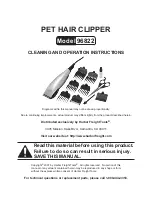
3
group of vehicles*, it may order a recall and remedy
campaign. However, NHTSA cannot become involved in
individual problems between you, your dealer, or The Toro
Company.
To contact NHTSA, you may call the Vehicle Safety Hotline
toll-free at 1–888–327–4236 (TTY: 1–800–424–9153); go to
http://www.safercar.gov
; or write to: Administrator, NHTSA,
400 Seventh Street, SW., Washington, DC 20590. You can
also obtain other information about motor vehicle safety from
http://www.safercar.gov.
* brush chipper trailer
Training
•
Read the
Operator’s Manual
and other training material. If
the operator(s) or mechanic(s) can not read English, it is the
owner’s responsibility to explain this material to them.
•
Do not allow anyone to operate the machine who has not
read the
Operator’s Manual
or has not been instructed on the
safe use of the machine.
•
Never let children or untrained people operate or service the
equipment. Local regulations may restrict the age of the
operator.
•
All operators and mechanics should be trained. The owner is
responsible for training the users.
•
Keep the operator zone and adjacent area clear for safe,
secure footing.
Towing
Check with your local county or state safety towing
regulations, in addition to meeting Department of
Transportation (DOT) Safety Towing Regulations, before
towing the machine.
•
In order to reduce the possibility of an accident while
transporting the machine on public roads, ALWAYS make
sure the towing vehicle is mechanically sound and in good
operating condition.
•
ALWAYS shutdown engine before transporting the
machine.
•
ALWAYS inspect the hitch and coupling for wear. NEVER
tow the machine with defective hitches, couplings, chains,
etc.
•
Check the tire air pressure on both towing vehicle and
machine. The tires should be inflated to 60 psi (410 kpa) cold.
•
Check the tire tread for wear.
•
ALWAYS properly attach the safety chains to towing
vehicle.
•
ALWAYS make sure that the towing vehicle’s directional,
backup, and brake lights are working properly.
•
Avoid sudden stops and starts. This can cause skidding, or
jack knifing. Smooth, gradual starts and stops will improve
towing.
•
Avoid sharp turns to prevent rolling. Tow only with a
vehicle that has a hitch designed for towing. Do not attach
towed equipment except at the hitch point.
Before towing check to make certain your machine is
correctly and securely attached to the towing vehicle.
•
Be sure that the ball hitch you are using is the proper size
for the hitch coupler on the machine.
•
Be sure the safety chains are properly hooked to the vehicle
leaving enough slack for turning.
•
Be sure the jack stand is secured in the UP position.
•
Do not tow the machine faster than 45 mph (75 km/h).
•
Use caution when backing up; use a spotter outside the
vehicle to guide you.
•
Do not allow anyone to sit or ride on unit when towing.
•
Never carry any cargo or wood on unit when towing.
•
Always disconnect the unit from the tow vehicle before
using it.
•
Place chock blocks underneath wheel to prevent rolling
while unit is parked.
Preparation
Become familiar with the safe operation of the equipment,
operator controls, and safety signs.
•
Always wear safety glasses or safety goggles while
operating this machine.
•
Wear tight fitting gloves without draw strings or loose cuffs.
•
Never wear jewelry or loose clothing that might become
entangled in moving or rotating parts of the machine.
•
Wear shoes with non-slip treads when using your machine.
If you have safety shoes, we recommend wearing them. Do
not use the machine while barefoot or wearing open sandals.
•
Wear long pants while operating the machine.
•
Use ear protectors or ear plugs to protect your hearing.
•
Make sure the machine is on level surface before operating.
•
Always operate the machine from the side of the hopper.
•
Block the wheels of the machine to prevent unintended
movement.
•
Use extra care when handling gasoline and other fuels. They
are flammable and vapors are explosive.
•
Use only an approved fuel container.
•
Never remove the gas cap or add fuel when the engine is
running. Allow the engine to cool before refueling. Do not
smoke.
•
Never refuel or drain the machine indoors.
•
Replace gasoline cap and tighten securely.
•
Keep container nozzle in contact with the tank during
filling.
•
If gasoline is spilled, wipe it off the engine and equipment.
Operation
Before every use:
•
Inspect the coupler, ball and hitch.
•
Always use safety chains.
•
Verify all lights are functioning properly.
•
Verify the tires are properly inflated as recommended.
•
Verify lug nuts are tight and torqued properly.
•
Machine is properly secured.
•
Before starting this machine, review the “Safety
Instructions.” Failure to follow these rules may result in
serious injury to the operator or bystanders.
Содержание 22604
Страница 19: ...19 Notes ...




































